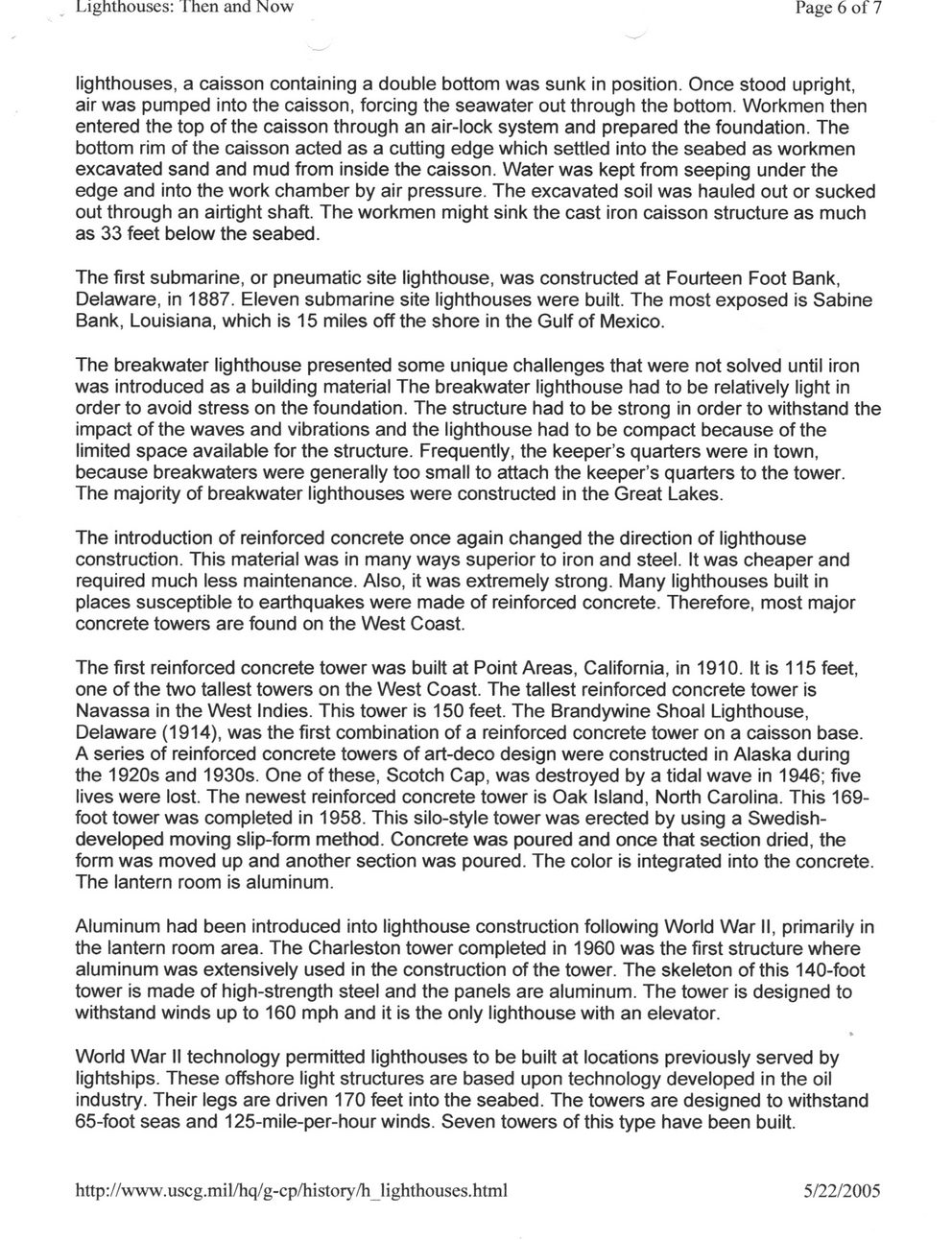This text was obtained via automated optical character recognition.
It has not been edited and may therefore contain several errors.
Lighthouses: Then and Now Page 6 of 7 lighthouses, a caisson containing a double bottom was sunk in position. Once stood upright, air was pumped into the caisson, forcing the seawater out through the bottom. Workmen then entered the top of the caisson through an air-lock system and prepared the foundation. The bottom rim of the caisson acted as a cutting edge which settled into the seabed as workmen excavated sand and mud from inside the caisson. Water was kept from seeping under the edge and into the work chamber by air pressure. The excavated soil was hauled out or sucked out through an airtight shaft. The workmen might sink the cast iron caisson structure as much as 33 feet below the seabed. The first submarine, or pneumatic site lighthouse, was constructed at Fourteen Foot Bank, Delaware, in 1887. Eleven submarine site lighthouses were built. The most exposed is Sabine Bank, Louisiana, which is 15 miles off the shore in the Gulf of Mexico. The breakwater lighthouse presented some unique challenges that were not solved until iron was introduced as a building material The breakwater lighthouse had to be relatively light in order to avoid stress on the foundation. The structure had to be strong in order to withstand the impact of the waves and vibrations and the lighthouse had to be compact because of the limited space available for the structure. Frequently, the keeper’s quarters were in town, because breakwaters were generally too small to attach the keeper’s quarters to the tower. The majority of breakwater lighthouses were constructed in the Great Lakes. The introduction of reinforced concrete once again changed the direction of lighthouse construction. This material was in many ways superior to iron and steel. It was cheaper and required much less maintenance. Also, it was extremely strong. Many lighthouses built in places susceptible to earthquakes were made of reinforced concrete. Therefore, most major concrete towers are found on the West Coast. The first reinforced concrete tower was built at Point Areas, California, in 1910. It is 115 feet, one of the two tallest towers on the West Coast. The tallest reinforced concrete tower is Navassa in the West Indies. This tower is 150 feet. The Brandywine Shoal Lighthouse, Delaware (1914), was the first combination of a reinforced concrete tower on a caisson base. A series of reinforced concrete towers of art-deco design were constructed in Alaska during the 1920s and 1930s. One of these, Scotch Cap, was destroyed by a tidal wave in 1946; five lives were lost. The newest reinforced concrete tower is Oak Island, North Carolina. This 169-foot tower was completed in 1958. This silo-style tower was erected by using a Swedish-developed moving slip-form method. Concrete was poured and once that section dried, the form was moved up and another section was poured. The color is integrated into the concrete. The lantern room is aluminum. Aluminum had been introduced into lighthouse construction following World War II, primarily in the lantern room area. The Charleston tower completed in 1960 was the first structure where aluminum was extensively used in the construction of the tower. The skeleton of this 140-foot tower is made of high-strength steel and the panels are aluminum. The tower is designed to withstand winds up to 160 mph and it is the only lighthouse with an elevator. World War II technology permitted lighthouses to be built at locations previously served by lightships. These offshore light structures are based upon technology developed in the oil industry. Their legs are driven 170 feet into the seabed. The towers are designed to withstand 65-foot seas and 125-mile-per-hour winds. Seven towers of this type have been built. http://www.uscg.mil/hq/g-cp/history/h_lighthouses.html 5/22/2005

Lighthouses Chronology-of-Aids-to-Navigation-(06)-(1)